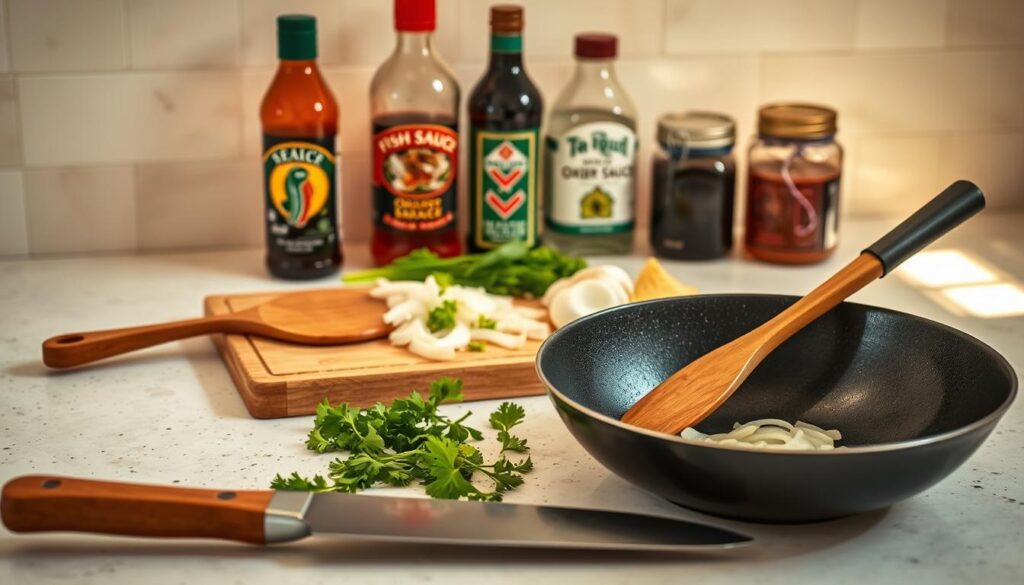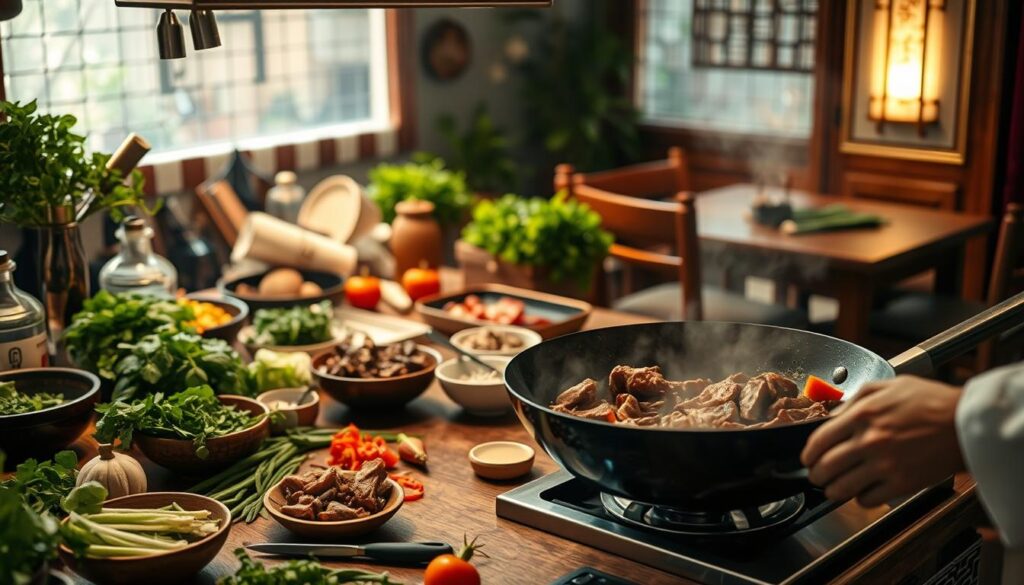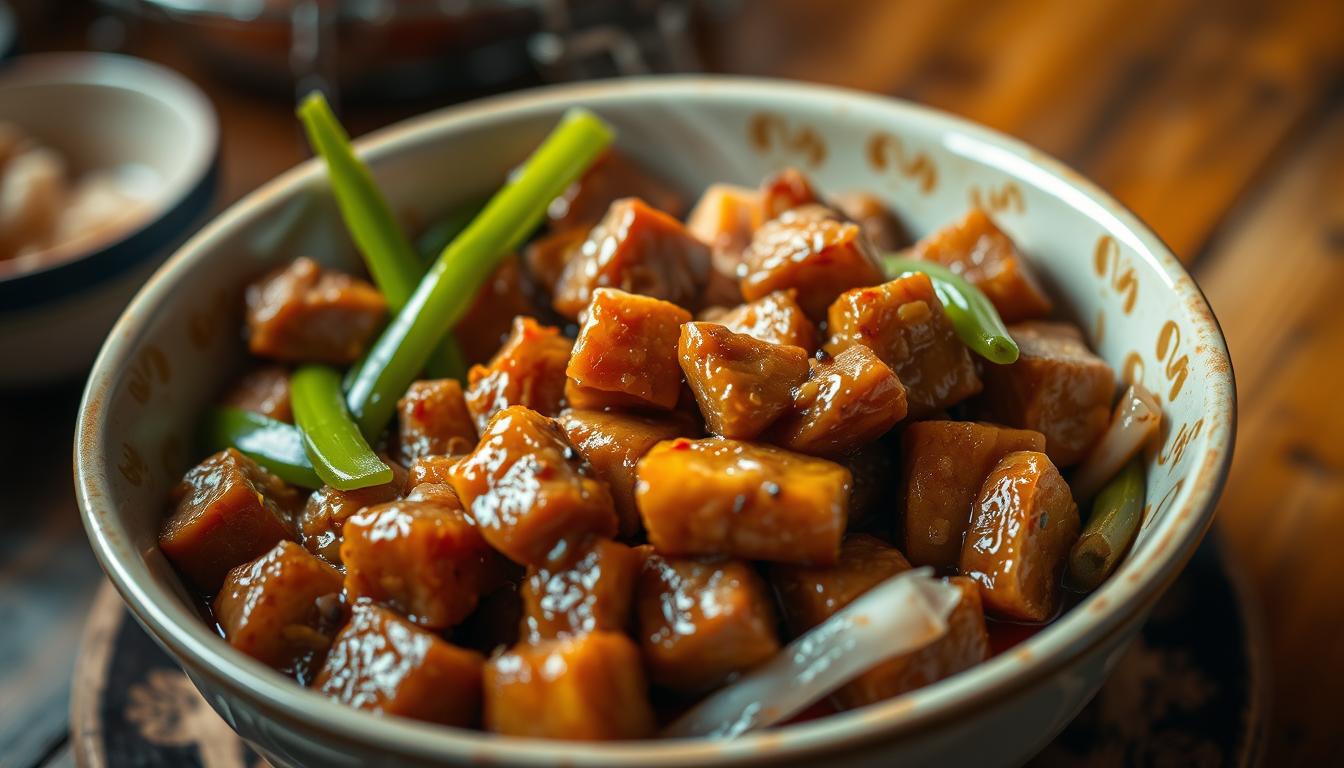Table of Contents
There’s something special about a dish that feels both cozy and new. My first taste of Bò lúc lắc—a mix of seared beef and tangy sauce—captured my heart. Now, I’m excited to share my favorite bo luc lac recipe with you. It’s more than a meal; it’s a feast of flavors that mix salty, sweet, and umami perfectly.
Key Takeaways
- A step-by-step how to make bo luc lac guide for home cooks.
- Pro tips for tender beef and vibrant flavors.
- Cultural insights behind Vietnam’s iconic shaking beef.
- Substitutions for ingredients like fish sauce or star anise.
- Serving ideas to make your dish restaurant-worthy.
What Is Bò Lúc Lắc? Introduction to Vietnamese Shaking Beef
Traditional bo luc lac is more than a meal. It’s a celebration of flavor and tradition. This dish, known as vietnamese shaking beef, combines tender beef with vibrant seasonings. It embodies the essence of Vietnamese street food culture.
The Cultural Significance of Bò Lạc Lắc in Vietnam
In Vietnam, traditional bo luc lac is a symbol of joy. Families serve it during festivals or gatherings. Its bold taste mirrors the country’s passion for bold, layered flavors.
Street vendors and home cooks prepare it with care. It’s a staple for both casual meals and festive occasions.
Why It’s Called “Shaking Beef”
The name vietnamese shaking beef comes from the cooking method. Chefs shake the wok vigorously while searing the beef. This ensures even seasoning and a crispy exterior.
This technique prevents the meat from drying out. It creates a dish that’s both tender and caramelized. The motion is as much art as it is technique, a ritual passed down through generations.
My First Experience With This Iconic Dish
My first bite of traditional bo luc lac happened in Hanoi’s Old Quarter. At a bustling market stall, I watched as the chef shook the pan with rhythmic precision. The dish arrived sizzling, with beef marinated in fish sauce and garlic, paired with a tangy lime garnish.
Each bite was a surprise—sweet, salty, and smoky all at once. That moment ignited my mission to share this dish with others.
The History Behind Authentic Bò Lúc Lắc
Exploring the origins of authentic bo luc lac, I found its roots in Saigon in the 1950s. This dish was born during French colonial times. It mixed beef, a favorite of French cuisine, with local spices.
The name “lúc lắc” comes from the shaking motion used while cooking. French colonists introduced beef, but Vietnamese cooks added lemongrass, fish sauce, and chili. This mix made a dish that’s uniquely Vietnamese but influenced by the French.
Traditional bo luc lac shows this mix of cultures. It uses cast-iron pans, a French touch, but its flavors are distinctly Southeast Asian. Over time, it became a key part of HCMC’s street food scene, staying true to its roots.
Chefs today still argue over the right spice mix, showing how important tradition is. This debate highlights the dish’s rich history.
Even as it’s enjoyed worldwide, cooks focus on using fresh herbs and marinating techniques passed down through generations. My research shows that keeping these methods alive preserves the dish’s essence. Whether in Vietnam or New York City, authentic bo luc lac remains connected to its hybrid history.
Essential Ingredients for the Perfect Bò Lúc Lắc Recipe
Choosing the right ingredients is key to this iconic dish. My favorite bo luc lac recipe starts with top-notch beef and bold flavors. Here’s what I always have ready:
Selecting the Best Beef Cuts
I always pick well-marbled cuts like sirloin or ribeye. Their fat keeps the meat juicy during cooking. Thinly slicing against the grain makes it tender.
Key Aromatics and Vegetables
- Crushed garlic and shallots for umami depth
- Red bell peppers add a sweet crunch
- Lime juice brightens the final dish
- Cilantro for garnish
Traditional Bò Lúc Lắc Seasoning Components
The bo luc lac seasoning uses fish sauce, oyster sauce, and soy sauce. I mix these with sugar and black pepper. This blend gives the dish its unique flavor.
American Substitutions
No fish sauce? Use soy sauce mixed with lime juice. Swap cilantro for Thai basil if you need to. Always taste and adjust to keep it authentic.
Kitchen Equipment You’ll Need

To make vietnamese beef stir fry well, you need the right tools. A heavy skillet or carbon steel wok is best for high heat. A sharp knife is key for cutting beef cubes evenly, which helps in cooking.
Tongs are great for flipping meat without squishing it. This keeps the meat tender and juicy.
| Item | Purpose |
|---|---|
| Heavy skillet/wok | Delivers the sear that defines bo luc lac texture |
| Sharp knife | Cuts beef into consistent 1-inch cubes |
| Wide spatula | Essential for moving ingredients without overcrowding the pan |
Upgrades like a meat thermometer (for a 130°F internal temp) and a large platter for serving are nice. But, even basic tools can make a great dish. My first try was with a cast-iron skillet, and it was fantastic.
Pro tip: Use a bowl for tossing beef in marinade and serving sauce. For those on a budget, a nonstick pan is a good substitute. Serve with rice and herbs, like in other stir-fry recipes, for a complete meal.
Creating the Perfect Bò Lúc Lắc Marinade
At the heart of a great bo luc lac marinade is a mix of science and feeling. I found that lime juice’s acidity softens meat. Soy sauce and fish sauce add a rich flavor. Here’s how to make a marinade as good as restaurant-style shaking beef:
First, learn the science: acids tenderize, fats carry flavor, and umami deepens taste. Here’s what you need:
- Acid (lime juice): Use 2 tbsp per pound of beef to soften the meat.
- Umami boost: Mix 1 tbsp fish sauce and 1 tbsp soy sauce for a salty-sweet taste.
- Optional fat: A little coconut oil helps flavors stick to the beef.
Timing is crucial—marinate for 30 minutes to 2 hours. Longer and the meat might get too soft. My advice: marinate just enough to flavor, not too much.
My secret ingredient? Add 1 tsp caramelized sugar to the marinade. It caramelizes during cooking, giving a glossy crust. This trick is similar to making crab brûlée’s caramelized top, but for beef.
Be adventurous: Try adding lemongrass for brightness or rice wine for depth. Always taste the bo luc lac marinade before adding beef to get the flavors right.
Step-by-Step Bo Luc Lac Recipe: The Cooking Process

Learning the bo luc lac recipe begins with prep. My kitchen is always ready with onions chopped, peppers sliced, and marinade mixed. This prep keeps the cooking smooth.
- Heat a cast-iron skillet over high heat until smoking.
- Add marinated beef, then immediately shaking beef recipe technique begins—toss the meat rapidly for 20 seconds to form a golden crust.
- Reduce heat to medium, add aromatics, and shake gently to blend flavors.
Timing is key when searing. I wait for each beef slice to get a caramelized edge before adding veggies. For home stoves, I use medium-high heat to avoid burning. When it starts sizzling, it’s time to serve. My secret? Taste a piece to check for tenderness and a slight pink center.
Pro tip: Never overcrowd the pan. Work in batches if needed—this keeps the shaking motion effective. The “shaking” isn’t just flair; it ensures even seasoning and avoids overcooking. Watch for when the garlic and chili start to brown—that’s your cue to add the final sauce mix.
Serving Suggestions for Your Vietnamese Beef Stir Fry
When serving vietnamese beef stir fry, how you present it is as important as its taste. These tips will make your authentic bo luc lac a meal to remember.
Traditional Accompaniments
Here are the classic sides to go with your stir-fry:
- Watercress or mixed greens: They balance the beef’s strong flavor.
- Tomato-onion salad: A simple mix of diced tomatoes, onions, and fish sauce dressing.
- Rice options: Choose traditional broken rice (cơm tấm) or jasmine rice for a more familiar taste.
Plating for Visual Appeal
Arrange beef slices artfully on a bed of greens. Drizzle excess sauce into small wells for dipping. Add lime wedges and crushed peanuts for extra texture.
Complementary Beverages
| Beverage | Why It Works | Example |
|---|---|---|
| Vietnamese iced coffee | Strong flavor cuts through richness | Phin drip coffee with condensed milk |
| Riesling | Acidity contrasts sweet-savory notes | Off-dry German Riesling |
| Coconut water | Refreshes the palate | Freshly opened coconut water |
My favorite way to serve it? A vibrant plate with broken rice, greens, and that iconic lime-salt-pepper sauce on the side. Guests always ask for the recipe when they see it presented this way!
Delicious Variations on Traditional Bò Lúc Lắc
Once you’ve mastered the traditional bo luc lac, it’s time to try new twists. These changes honor the dish’s roots while adding something new. Here are my top picks that keep the essence of the dish:
- Lemongrass Twist: Add fresh lemongrass to the marinade for a citrusy scent that matches the beef’s richness.
- French-Vietnamese Fusion: Mix in a knob of butter when deglazing the pan for a smooth, rich sauce.
- Gluten-Free Option: Use tamari instead of soy sauce and gluten-free fish sauce substitutes to keep the umami without changing the texture.
- Bourbon Marinade: Replace ¼ cup of water in the marinade with bourbon for a smoky flavor that goes well with grilled veggies.
| Variation | Key Change | Flavor Profile |
|---|---|---|
| Lemongrass Twist | Added lemongrass in marinade | Clean, herbal brightness |
| French-Vietnamese Fusion | Butter in sauce | Lush, creamy |
| Gluten-Free | Tamari substitution | Savory with saltiness intact |
| Bourbon Marinade | Bourbon in marinade | Smoky, complex |
Remember, the heart of vietnamese shaking beef is the sear, the shaking technique, and balanced flavors. These changes have been tested and loved by friends and food bloggers. They work best when 80% of the recipe stays true to tradition. Be bold but respectful in your experiments—your taste buds and heritage will appreciate it!
Conclusion: Mastering the Art of Bò Lúc Lắc at Home
Learning to make shaking beef is more than following steps. It’s about feeling the rhythm of the wok and trusting your instincts. Every time I cook this dish, I learn something new. From balancing the marinade to mastering the “shaking” motion, it’s a journey.
The goal is to make that restaurant-style shaking beef at home. But it takes patience. My early attempts taught me that marinating time and fresh ingredients are key.
Start with quality ingredients like well-marbled steak and fresh herbs. Adjust the fish sauce and lime juice to taste. Don’t be afraid to experiment. The first time I used store-bought fish sauce versus Phu Quoc, I noticed a big difference in flavor.
Share your versions online or with friends. Every cook’s journey is unique. Keep practicing, and soon your kitchen will serve up dishes as vibrant as any Vietnamese eatery. The joy of this recipe is in its adaptability and the pride of serving a dish that’s both personal and authentic. Bon appétit!

